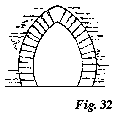CONSTRUCTION X. THE ARCH LINE 161
importance, but which are all included, with English lancet, under the term, relative pointed of the horseshoe arch.
§ 15. The groups above described are all formed of circular arcs, and include all truly 
§ 16. We are, however, concerned to notice the absurdity of another form of arch, which, with the four-centred, belongs to the English perpendicular Gothic.
Taking the gable of any of the groups in Fig. 31 (suppose the equilateral), here at b, in Fig. 33, the dotted line representing the relative pointed arch, we may evidently conceive an arch formed by reversed curves on the inside of the gable, as here shown by the inner curved lines. I imagine the reader by this time knows enough of the nature of arches to understand that, whatever strength or stability was gained by the curve on the outside of the gable, exactly so much is lost by curves on the inside. The natural tendency of such an arch to dissolution by its own mere weight renders it a feature of
1 [The MS. here inserts:-
“But even the pure ellipse is a barbarism, it being always wrong to use a difficult curve when one easily built would have done as well (there may perhaps be some reason for it in the Trinita bridge, connected with the nature of the floods of the Arno; on this point I cannot speak with certainty”).]
IX. L
[Version 0.04: March 2008]